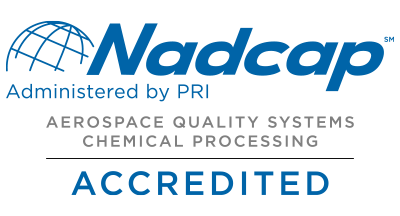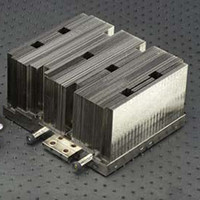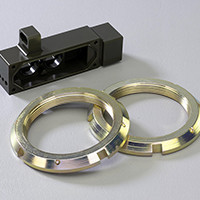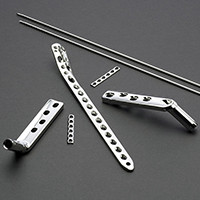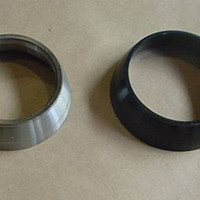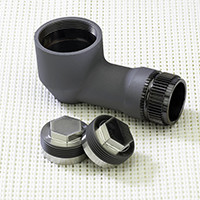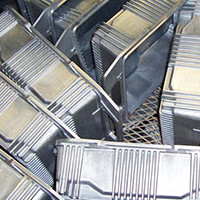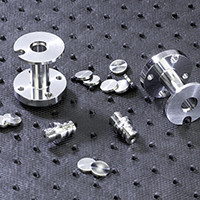Anodizing
Anodizing is an electrochemical conversion process that forms an oxide film, usually on aluminum, in an electrolyte (chemical solution). The aluminum parts are the anode (thus the term “anodizing”) and current is passed between them and a cathode, usually flat aluminum bars, through the above mentioned electrolyte (sulfuric acid is most commonly used). There are different types of anodize, most commonly referred to as Type I-Chromic Acid Anodize, Type II-Sulfuric Acid Anodize, and Type III Hard Anodize or Hardcoat Anodize from the Mil-A-8625 designation. Other less common types are phosphoric acid and titanium anodize.
Electroless Plating
Electroless Plating is the process of applying one or more layers of a metal to a substrate without the use of an external electrical charge. It is also sometimes called autocatalytic because the metal being applied is in solution and adheres itself to the substrate (plastic or ceramic included) without the use of an outside power source, (electric current, for example in electroplating). Due to the lack of electricity, electroless plating results in a completely uniform deposit, even on complex shapes, to improve wear and/or corrosion resistance, or to improve the solderability on selected materials.
Electroplating
Electroplating is the process of applying one or more layers of a metal to a part by passing a positively charged electrical current through a solution containing dissolved metal ions (anode) and a negatively charged electrical current through your part to be plated (cathode). The history dates back to the ancient Egyptians who would coat metals and non-metals with gold or a process known as “gilding”, the first known surface finish. Some metals apply more evenly than others, but the use of electricity means that the metal being deposited flows more easily to high current areas or the edges of a part. This tendency is especially pronounced on complex shapes or when trying to plate the inside or ID portion of a part. In addition to just single metals being applied, it is possible to simultaneously plate alloys of materials such as Tin and Lead or Zinc and Iron to achieve desired customized properties.
Electropolishing
Electropolishing is the process of smoothing and/or brightening a metal surface anodically in a concentrated acid or alkaline solution. Anoplate is set up to perform it on either Stainless Steel or other Nickel rich alloys (such Kovar and Invar). While it can be done on many base metals as a preplate operation, it is commonly done on Stainless Steel as a final finish. It provides a chemically and physically clean surface and removes any mechanical surface asperities which may be detrimental to the production of uniform and pit-free electroplated surfaces or the future performance and appearance of a Stainless Steel product.
Conversion Coatings
Conversion coatings is a generic term used to refer to a coating produced by a chemical or electrochemical treatment of a metallic surface that gives a superficial layer containing a compound of the metal. For ease of explanation we are going to further sub-divide this category into Steel Conversion Coatings (Black Oxide & Phosphate), Chromate Conversion coatings, and Anodize which is covered elsewhere.
Dry Film Lubricants
Dry Film Lubricants, also referred to as dry lubes or solid film lubes, provide protection from damage during relative movement and to reduce friction and wear. Anoplate typically sprays them on much like paint, though they can be dipped. Perhaps the most commonly used dry film lubricants are the inorganic compounds graphite and molybdenum disulfide (MoS2) and the polymer material PTFE (polytetrafluoroethylene). They have very high lubricating properties allowing applications where one wishes to reduce friction and cannot have wet greases or oils present. Though they may be used as a replacement to greases and oils, they are sometimes used as a “back-up” lubricant, under the grease so that lack of addition of grease will not cause failure.
Vacuum Impregnation
Vacuum Impregnation is a sealing treatment of porous castings with a medium by filling the pores with a thermosetting polyester resin under pressure to stop pressure leaks. The castings may have leaks, cracks, and voids that are created in the base material during the manufacturing or subsequent machining processes. Here at Anoplate we are typically asked to provide this along with another finish such as Chemical Film on an Aluminum casting. Vacuum Impregnation benefits include: eliminates leaks, greatly reduces scrap, eliminates In Process testing, and extends Tool Life - particularly in powder metal parts.
Passivation
Passivation is used to improve the surface condition of stainless steel by dissolving the iron that is embedded in the surface by forming, machining, or other manufacturing steps. If allowed to remain the iron corrodes and often gives the appearance of large or small rust spots on the stainless steel. In order to prevent this condition on the finished parts, they are given a passivation treatment. This treatment, which consists of immersing the stainless steel parts in a solution of nitric acid without oxidizing salts for a specific period of time, will dissolve the embedded iron and restore the original corrosion-resistance surface by forming a thin transparent oxide film. Passivating is used as the cleaning operation for castings, stampings and finished machine parts by immersing the parts.

